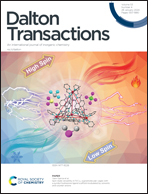Ni–Co–Mn complexed 3,4,9,10-perylenetetracarboxylic acid complexes as novel organic electrode materials for lithium-ion batteries†
Abstract
Ni–Co–Mn complexed 3,4,9,10-perylenetetracarboxylic dianhydride (PTCDA-NiCoMn) is prepared by hydrolysis of 3,4,9,10-perylenetetracarboxylic dianhydride (PTCDA) and complexed reaction with Ni, Co and Mn ions. At the same time, graphene was added to PTCDA-NiCoMnin situ to obtain graphene in situ composited Ni–Co–Mn complexed 3,4,9,10-perylenetetracarboxylic dianhydride composites (PTCDA-NiCoMn-G). The prepared PTCDA-NiCoMn composite exhibited a fibrous structure, and the number of pore units increased with the expansion of the fibrous structure. After the in situ recombination of graphene, shorter PTCDA-NiCoMn tubular fibers were dispersed between the thin layers of graphene, showing a larger surface area with more PTCDA-NiCoMn active components exposed, which is conducive to better electrochemical properties. As a result, the initial charge/discharge capacities of PTCDA-NiCoMn and PTCDA-NiCoMn-G electrodes are 1972.9 and 1806.6 mA h g−1 with initial coulombic efficiencies of 56.3% and 62.52%, respectively, at 100 mA g−1. After 200 cycles, the charge/discharge capacities of PTCDA-NiCoMn and PTCDA-NiCoMn-G are 617.0 and 876.4 mA h g−1 with capacity retention ratios of 51.4% and 73.0% at 100 mA g−1, respectively. Similarly, PTCA-NiCoMn-G electrodes show higher capacities than the PTCA-NiCoMn electrode at different current densities of 0.1, 0.2, 0.5, 1.0, 2.0 and 5 A g−1. The results show that PTCDA-NiCoMn-G electrode displays superior capacity, ICE, cycle and rate behaviors. The complexation of NiCoMn reduces the solubility of the PTCDA active units in the electrolyte, and the in situ recombination of graphene increases the dispersion of the active components, exposes more active sites, and effectively improves the conductive performance, which contributes to the electrochemical properties of the PTCDA-NiCoMn-G electrode.



 Please wait while we load your content...
Please wait while we load your content...